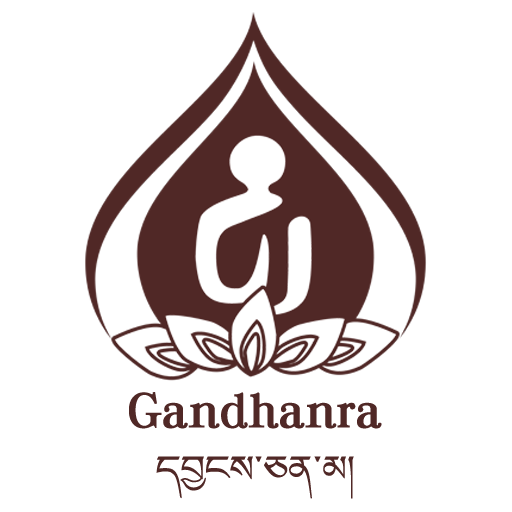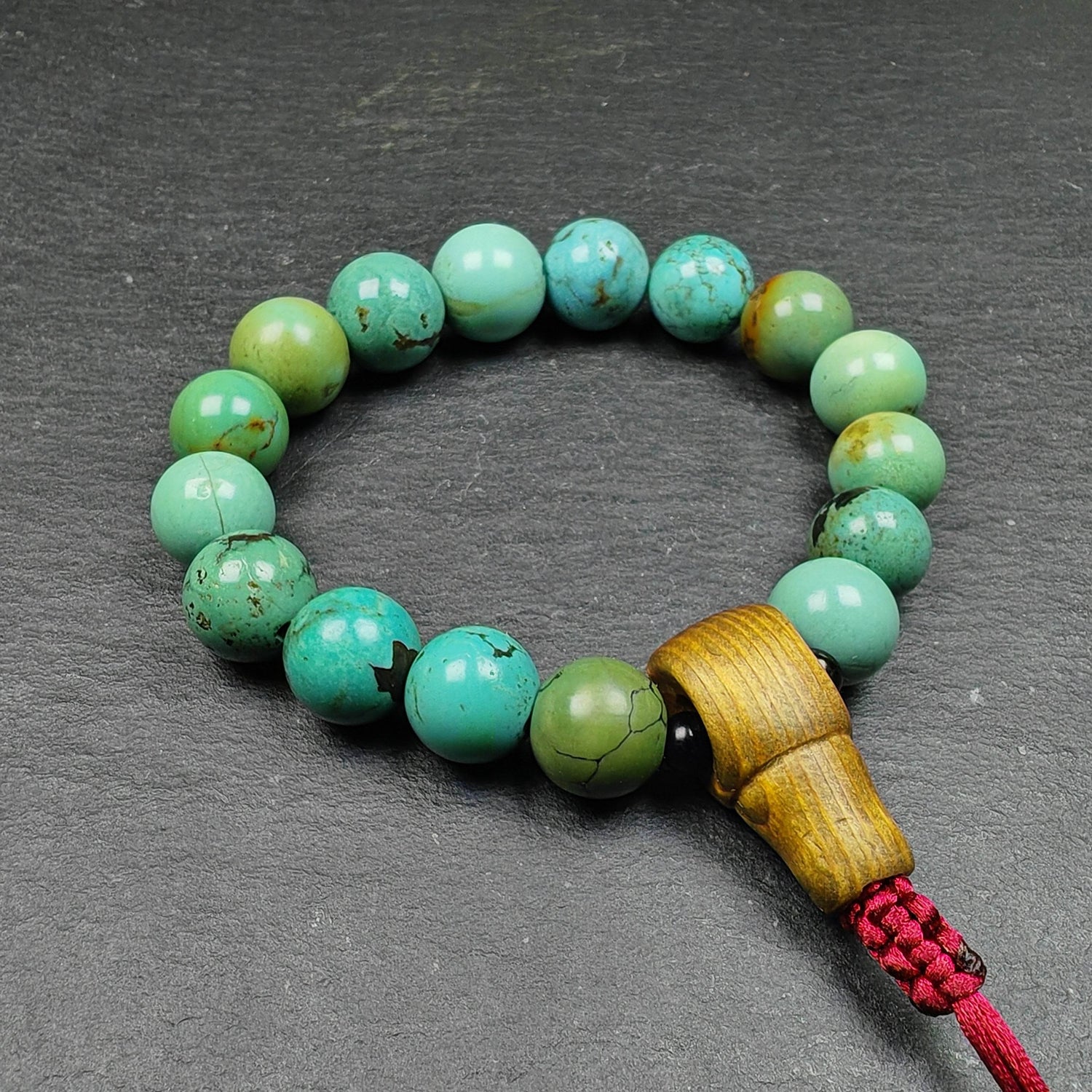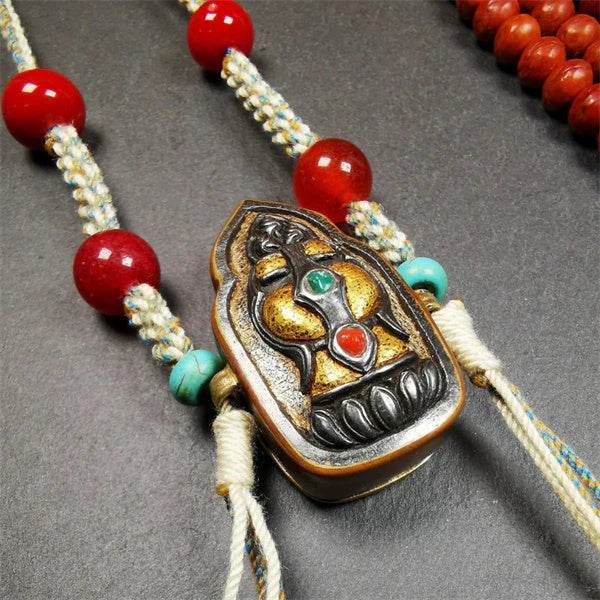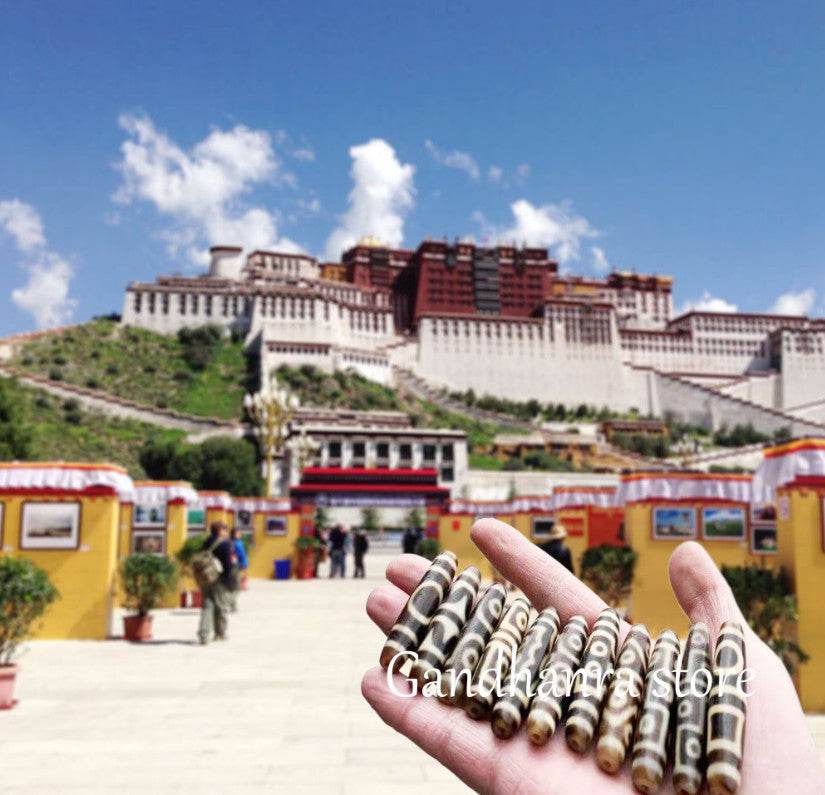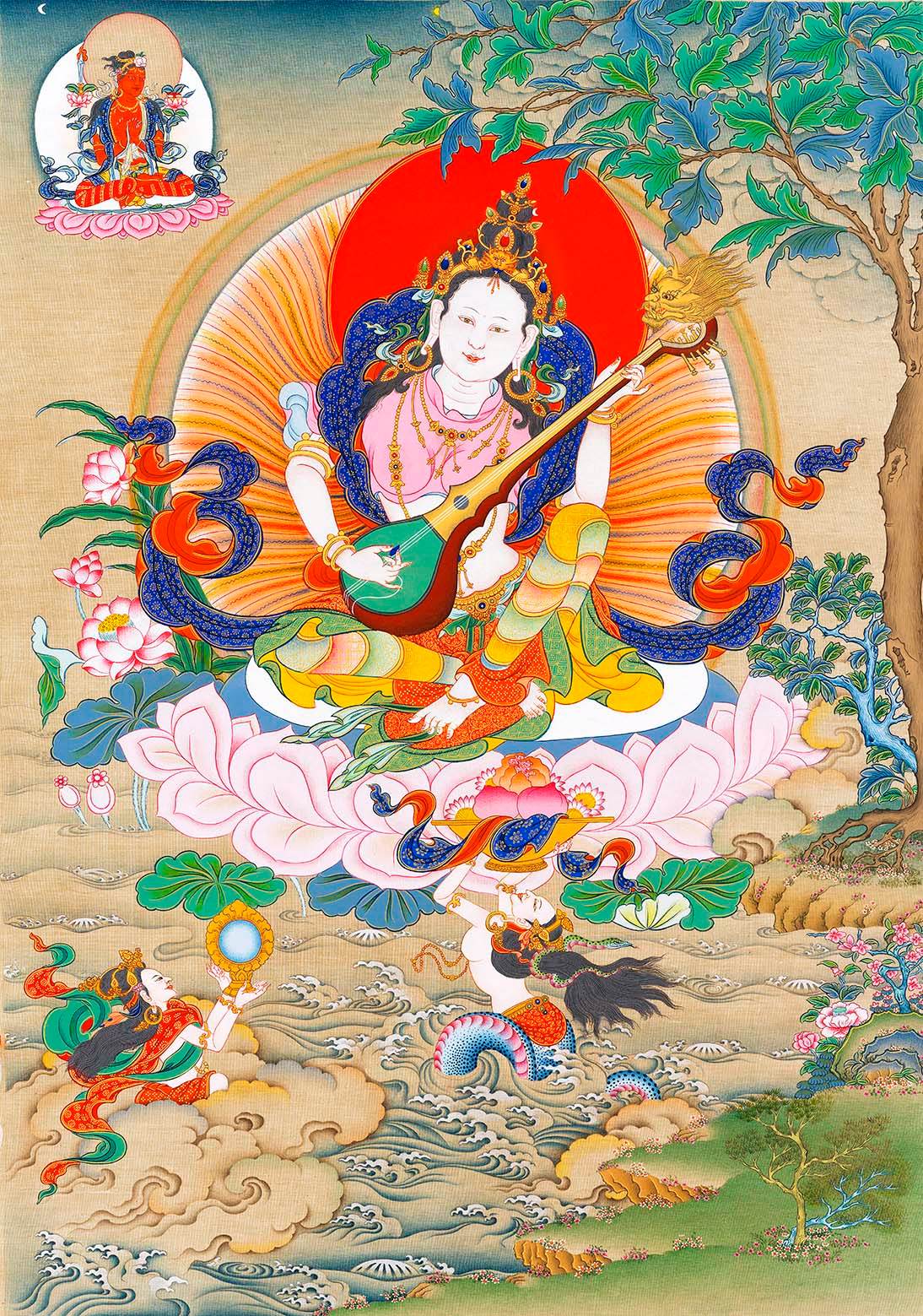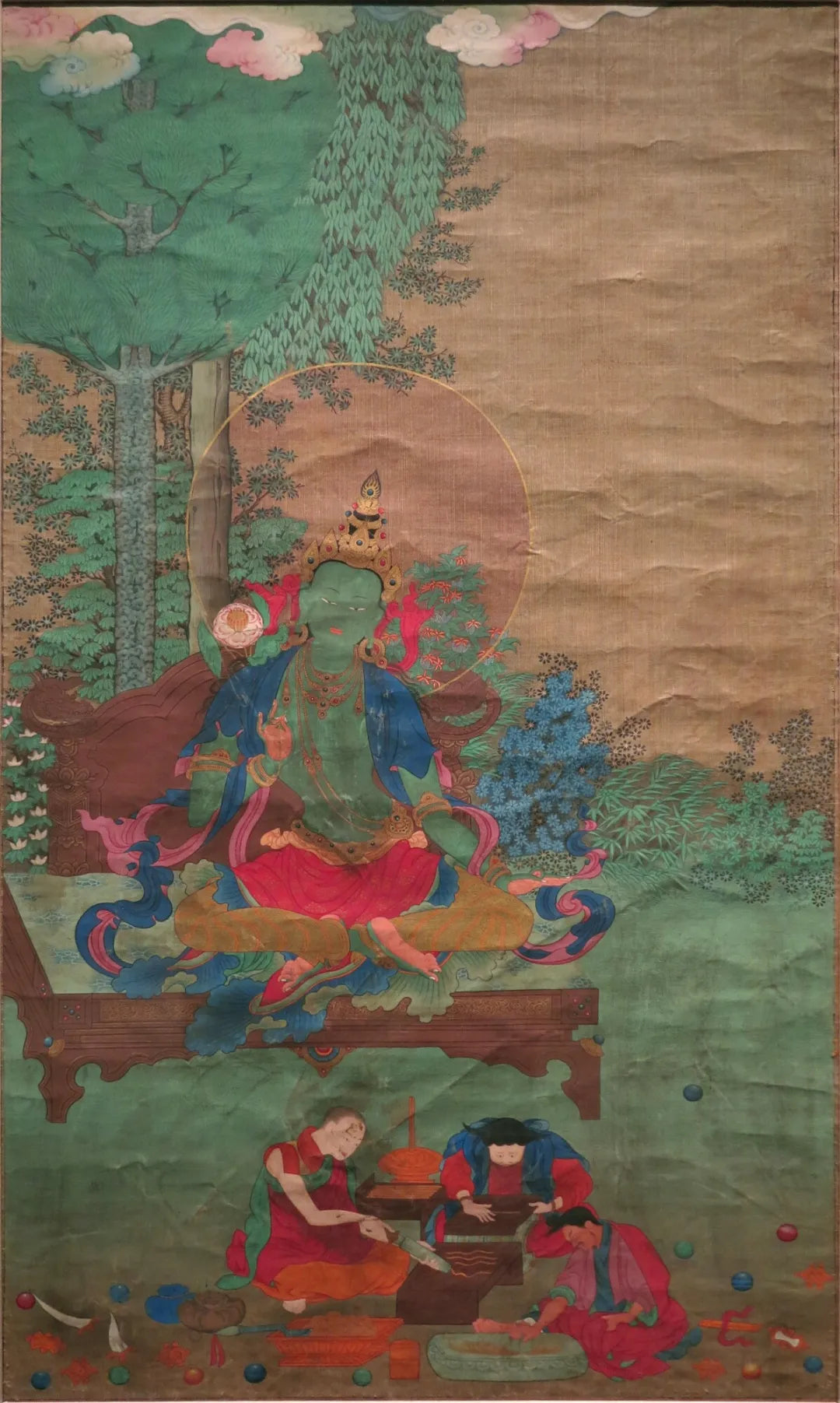
Discussing Incense Offering at the Guimet Museum in Paris

"The Pagoda-shaped Incense Burning Altar within Barkhor Street"
1987, image selected from the "Atlas of Lhasa" (2001)

"The Buddha Unveiling Ceremony at Drepung Monastery Shrouded in the Mist of Burning Incense"
From the "Tibet Series Photo Album: Drepung Monastery" (1999)

"Panoramic View of Samye Monastery"
Late 18th to mid-19th century, Collection of the Newark Museum
Detail: The Incense Burning Altar beside the Abbot's Throne
As a core symbol of Tibetan material civilization and spiritual world, the culture of incense (including the practices of burning Sang and incense) has long been an important subject of academic research and discussion. Previously, the author systematically introduced the origins of Tibetan incense culture, its status in both sacred and secular contexts, the aromatic substances from foreign or local sources, as well as the classical techniques and unique interpretations related to incense culture in eight articles. As the Tibetologist Chabpel Tseten Phuntsok (1922-2013) stated in his article "The Custom of Tibetan Ritual Incense Burning" (published in Tibetan in the 4th issue of "China Tibetology" in 1988 and in English in 1991): incense culture transcends differences arising from time, space, ethnicity, culture, and social strata, and has become an inseparable part of Tibetan culture. To further introduce Tibetan incense culture, the author will selectively translate an article on this topic by French scholar Nathalie Bazin, titled "The Art of Incense Offering in Tibetan Buddhism." Nathalie Bazin, who has long been associated with the Guimet Museum in France, specializes in the organization, research, and curation of Himalayan collections. The article was first published in the special issue "Aromas and Rituals in Asia" of the "Journal of the Royal Asiatic Society" (2013), and all images used are supplemented by the translator.

"Offering Goddess: The Incense Bearer"
19th century, Collection of the Art Gallery of New South Wales

"Vajra Eater/Dakini of Consumption/Vajra Dakini of Obstacle Removal"
Late 16th century, Private Collection
Originally a purification deity within the teachings of Chakrasamvara - वज्रडाक (Vajraḍāka)
Also known as རྡོ་རྗེ་མཁའ་འགྲོ་ (Dorje Khandro, with some manuscripts recording it as རྡོ་རྗེ་དཔའ་བོ་)
Common iconography features the "upper deity and lower incense burner"
If sesame seeds are burned in the incense burner, the fragrant smoke emerges from the mouth
(Accompanied by three fruits/འབྲས་བུ་གསུམ་ or six medicinal substances/བཟང་པོ་དྲུག་)
Through this smoke, it is believed to remove negative karma, ailments, and various obstacles

"The Base Incense Burner of Vajra Eater/Dakini of Consumption/Vajra Dakini of Obstacle Removal"
Mid-17th century, Private Collection
In Tibetan Buddhist art, certain iconographic themes and artifacts attest to the significance of incense offering rituals: incense is associated with diligence, which leads to enlightenment. Offering the "Five Desirable Offerings" to the gurus and peaceful deities to please them, thereby demonstrating the devotee's commitment to renounce sensory pleasures, is one of the most important rituals in Tibetan Buddhism. There are five Vajra goddesses symbolizing the five desirable offerings, among which the goddess representing fragrance (olfactory) is the Incense Vajra Goddess (गन्ध/गन्धवज्र; དྲི་རྡོ་རྗེ་མ་). Although her skin color varies, she is commonly depicted holding a conch filled with aromatic liquid. The Incense Bearer (धूप; བདུག་སྤོས་མ་) is the embodiment of incense burning, one of the four goddesses (flowers, incense, lamps, and ointments). The Incense Bearer is usually depicted with a dark complexion, holding incense utensils [translator's note: incense burner, incense tray, incense bowl], and the Incense Vajra Goddess often belongs to this group [translator's note: i.e., the Ointment Goddess; དྲི་ཆབ་མ་]. The Incense Bearer and the Ointment Goddess can appear with one face and two arms or three faces and six arms, and they appear in various mandala themes.
Western Tibet holds a significant place in the religious and art history of the later dissemination period of Buddhism, with some of the most exquisite murals in Tibetan art history completed in this region during the 11th century. 1. On the first level of the Sumtsek Temple at Alchi, there are ten magnificent mandalas painted on the walls, some of which feature Vairocana, the "illuminating" central deity, with four faces and as the lord of the Vajradhatu; the four offering goddesses are depicted at the four corners of the square, representing the four directions. 2. In the village of Piyang (ཕྱི་དབང་།), there are numerous Buddhist caves [translator's note: meditation caves/worship caves; now part of the Donggar-Piyang site complex], famously known as the "Cave of the Offering Goddesses". Originally, there was a clay sculpture in the three niches of this cave, and the deities depicted on the cave walls are part of the mandala of the central deity (the clay sculpture). The mandala murals reference the scriptures translated at the beginning of the later dissemination period. The Incense Bearer, with a dark complexion and richly dressed, appears twice in the mandala: 1. Holding an incense bowl painted with bird patterns in her right hand; 2. The incense bowl is placed on a lotus, and the Incense Bearer holds the lotus stem with both hands in a gesture of reverence.

"Vajradhatu/Vairocana Mandala"
Late 14th century, Kronos Collections
Note: The arrangement of the offering goddesses is similar to that in the murals of Alchi Monastery.

"Black Practitioner Lineage/Chakrasamvara Mandala"
Late 13th to early 14th century, Pritzker Collection
Note: Below are sixteen offering goddesses.
Similarly, within mandalas, the two goddesses often appear in three-dimensional forms, a notable example being found in the central hall of Tabo Monastery (ཏ་པོ་དགོན་). In 996, King Yeshe Ö (ཡེ་ཤེས་འོད་; 947-1024/1031) of Guge initiated the construction of Tabo Monastery, now located in the Spiti Valley. In 1042, the kingdom further renovated the central hall of the monastery, where the painted clay sculptures are part of the Vairocana mandala [translator's note: including sculptures of offering goddesses and related metal decorations]. The Bodhisattva of Fragrant Hands (དྲི་ལྡན་ཕྱག་), one of the "Sixteen Bodhisattvas of the Auspicious Aeon," is also commonly found in the layouts of mandalas with different themes [translator's note: also translated as the Bodhisattva of Fragrant Elephant; སྤོས་ཀྱི་གླང་པོ་].
In Tibetan Buddhist art, five types of items are often used to symbolize the five desirable offerings (which can correspond to the five Buddhas). Among these, the sense of smell is associated with Amitabha Buddha. In paintings, these items sometimes appear independently, while at other times they are grouped together on offering bowls, plates, or lotuses. They typically appear on the offering table in front of the main deity, at the bottom of the painting, or beside the landscape on either side. Horizontally depicted conch shells filled with aromatic liquids or oils represent the sense of smell. The conch shells are placed on the offering table or aligned with the fruit offerings representing taste. In some cases, the conch shells are also placed alongside musical instruments (such as cymbals and stringed instruments) representing hearing. It is important to note that in ancient South Asia, the conch shell had already become an important symbol of the main deity Vishnu, representing spiritual authority, and its loud sound could defeat enemies in war and declare victory [translator's note: see previous articles on conch shells]. Buddhists regard it as an important handheld object to signify the widespread proclamation of the Dharma. Therefore, when the conch shell is considered a musical instrument, it is usually depicted vertically in paintings, unlike its horizontal depiction when symbolizing the sense of smell. The aromatic liquid inside the conch shell is usually light blue, and occasionally yellow. In Buddhist narratives, the liquid inside the conch shell is saffron water or a five-fragrance water [translator's note: holy water containing sandalwood, musk, nutmeg, saffron, and camphor essence].

"Bodhisattva of Fragrant Hands/Bodhisattva of Fragrant Elephant"
Mid-14th century, Gilt Copper with Jewel Ornaments
Arthur M. Sackler Gallery Collection

"Trinity of Longevity: Ushnishavijaya"
Mid-18th century, Collection of the Guimet Museum
Note: The conch shell among the offerings at the bottom.

"Four Heavenly Kings: Virupaksha and Vaishravana"
Mid to late 19th century, Rubin Museum of Art Collection
Note: Offerings symbolizing the five desirable senses.
Cypress [translator's note: for the aromatic properties of pine and cypress, see previous articles] is the most important aromatic material in Tibetan incense culture and is considered a sacred tree in the pan-Himalayan region. In high-altitude areas above 3,000 meters, there are large cypress forests known as "fragrant forests" (with an average tree height of twelve meters). The leaves and branches of cypress emit a cinnamon-like fragrance, making it commonly used in various purification rituals. In 1057, the great master of the Kadam tradition, Dromtönpa (འབྲོམ་སྟོན་པ་; 1005-1064), founded Reting Monastery, which is situated within a cypress forest. In the historical accounts and legends of Reting Monastery, these cypress trees are distributed in different directions around the monastery, collectively forming a sacred landscape. The sacred cypress tree, with its seven layers of bark, is used to correspond to the Seven Buddhas, who in turn correspond to the seven revered teachers starting from Gendün Drupa. In many paintings depicting Dromtönpa [translator's note: especially those illustrating his previous lives and lineage], the central landscape of Reting Monastery is the cypress forest, with seven turquoise-colored sacred trees symbolizing the seven revered teachers. To this day, the cypress forest [translator's note: Tibet Reting National Forest Park] remains a place of worship, where any individual or group is strictly prohibited from cutting down trees. Moreover, the fragrance of cypress aids in meditation, stimulating deep levels of consciousness. During the Sang offering rituals, people burn cypress branches to seek the protection of deities. In traditional medicine, cypress is also an important medicinal ingredient.
In addition to cypress, there are nearly thirty other materials commonly used in making Tibetan incense, such as saffron, sandalwood, agarwood, and musk. In some rituals, people offer three types of incense to the upper, middle, and lower worlds, forming a mudra with the thumb and index finger while holding the incense with the remaining three fingers, and chanting mantras [translator's note: however, such incense-burning rituals are not common in Tibet]. In traditional offering arrangements, the fourth offering from the left (incense sticks placed in a bowl filled with rice or barley) is the incense offering. The fragrance attracts the Gandharvas (गन्धर्व; དྲི་ཟ་), who are celestial musicians and dancers (usually male singers and female dancers). The fifth offering is the lamp offering, symbolizing the light of wisdom. The sixth offering is the ointment offering (liquid aromatics, such as saffron water or flower water), symbolizing purity and cleanliness. These offerings must be consecrated by chanting mantras [translator's note: especially Om Ah Hum].

"Previous Lives and Lineage Series of the Master: Dromtönpa"
First half of the 18th century, Collection of the Palace Museum
Note: Reting Monastery and the cypress forest in the distance.

"Eight Bodhisattvas Series: Ksitigarbha Bodhisattva"
Late 18th century, Rubin Museum of Art Collection
Note: Below, monks and laypeople are making incense sticks.

"Golden Garland Lineage Series of the Kagyu Tradition: Trakpa Päljor"
Mid to late 18th century, Collection of Palpung Monastery, Dege
Detail: A disciple holding incense sticks.

"Four Heavenly Kings: Dhritarashtra"
Mid-17th century, The Jucker Collection
Detail: Gandharva (male incense eater) and Gandharvi (female incense eater)
Dhritarashtra is regarded as the spiritual leader of the Gandharvas.
In Tibetan Buddhist art, there are often highly attractive but differently shaped metal incense vessels. Furnace-shaped or bottle-shaped incense vessels are placed on tripod or quadripod bases, sometimes appearing suspended by three chains like traditional Christian incense vessels, or shaped like square boxes [Translator's note: For local names of incense vessels, please refer to previous articles on Tibetan incense]. Some extremely exquisite Tibetan incense vessels are produced in Derge, eastern Tibet, and the Guimet Museum houses one such incense box (eighty centimeters long) possibly from Derge. This metal incense box, dating back to the 16th or 17th century, is gilded and inlaid with turquoise, crystal, and lapis lazuli, with its surface engraved with jeweled curtains, sacred deer, and soaring dragons. The jeweled curtains seem to emerge from the mouth of the central glorious face (किरीटीमुख; ཙི་པ་ཊ་), whose claws tightly grip the curtains, and the moon ornament on its head may be carved from ivory [Translator's note: For more on the glorious face, refer to previous articles]. This metal incense box is deeply influenced by Central Plains styles. Additionally, the Guimet Museum holds a pair of 19th-century copper curtain-top chain incense burners with rows of lotus petal patterns. The surface is engraved with three glorious faces holding lotus curtains, adorned with strings of jewels below. This collection was donated in 1912 by the renowned French Tibetologist Jacques Bacot (1877-1965).

"Gilded Tibetan Incense Box Adorned with Jewels"
Eastern Tibet, 16th or 17th century
Collection of the Guimet Museum


Early 14th Century, Collection of the Guimet Museum


15th Century, Private Collection
